This is not a comprehensive cruising guide to the Kingdom of Tonga. It’s a quick reference resource to help you with the logistics: checking in/out, provisioning, refueling, etc., based on our personal experiences from June to August 2025. If you have recent updates or tips, feel free to share them in the comments. And if you found this helpful, don’t forget to subscribe and share! Fair winds, folks. 🙂
INTRODUCTION
- About Tonga (geography, population, religion, language)
- Currency conversions
- Health and hazards
- Local food and drinks
- Seasons/weather
CUSTOMS & IMMIGRATION
- Check-in procedure (Advanced Notification of Arrival, international and domestic check-in/out processes)
- Visa extensions
- Check-out procedure
NEIAFU, VAVA’U
- Mooring balls
- ATMs
- Trash disposal
- Yacht services (laundry, propane, fuel, etc.)
- Provisioning
- Parts & repairs
PANGAI, HA’APAI
- ATMs
- Trash disposal
- Fuel
- Provisioning
- Parts & repairs
INTRODUCTION
About Tonga: Tonga is made up of 170 islands, 45 of which are inhabited, with just over 100,000 people calling it home. Most of the population lives on Tongatapu, the largest island in the southernmost island group. The archipelago is divided into four main island groups: Tongatapu, Ha’apai, Vava’u, and the remote Niuas. Situated just west of the International Date Line, Tonga is one of the first places on Earth to greet each new day. The official languages are Tongan and English; the local currency is the Tongan paʻanga (TOP).
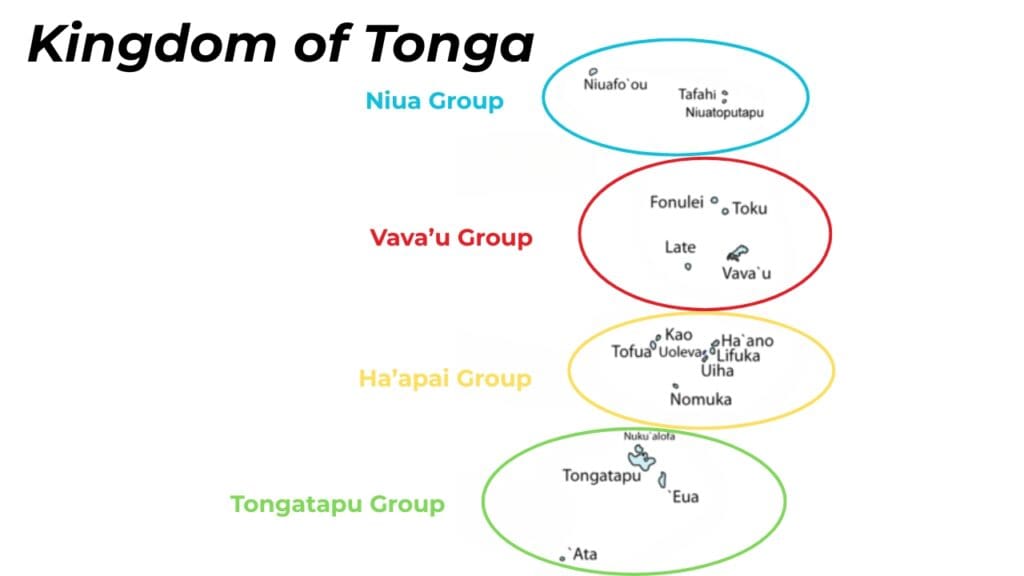
Currency Conversions: 1 TOP = 0.64 AUD, 0.70 NZD, 0.42 USD, 0.58 CAD, 0.37 EUR
Cultural Norms & Visitor Etiquette: Tonga is a Christian country, and modesty is highly valued. In tourist areas, wearing shorts and tank tops is generally acceptable, but when visiting villages or attending church, it is recommended to cover your shoulders and knees. Most businesses close on Sundays.
Health & Hazards: Tonga is home to Aedes mosquitoes, which transmit dengue, chikungunya, and zika viruses. To protect yourself from mosquito-borne illnesses in Tonga, wear long-sleeved clothing, use insect repellent with DEET, and use bug screens on open hatches/sleep under mosquito nets. Tonga lies in the Pacific “Ring of Fire,” making it vulnerable to earthquakes, volcanic eruptions, and tsunamis. Consider following Tonga Meteorological Services for updates during your stay, and check out this blog post about our experience responding to a tsunami warning while on anchor in Tonga!
Local Food and Drink:
- Coffee: Kingdom Koffie, Tupu’Anga Coffee
- Beer: Maka, Ikale, limited availability of imported beer
- Wine/spirits: Royal Spirits (produced in Tonga), limited availability of imported wine and spirits
- Fresh coconut juice is widely available.
- Kava, a traditional ceremonial drink, is commonly offered. It has a mildly sedating and numbing effect, so consume with caution.
- ‘Otai is a refreshing Tongan fruit drink usually served over ice, made with coconut milk, water, and grated fruit like watermelon, mango, or pineapple.
- A Tongan feast typically includes Umu, a cooking method in which food is wrapped in banana leaves and slow-cooked for hours in an underground oven lined with hot rocks. The food can include pork, beef, lamb, chicken, octopus, or vegetables.
Seasons/weather:
- Dry Season (May–October): Cooler, less humid, and considered a high season for tourism.
- Wet Season (November–April): Hotter, more humid, with an increased chance of tropical cyclones.
- Whale Season (July–October): Humpback whales migrate to Tonga to mate and give birth. Warning: Do not approach whales if you are not in a licensed whale-watching vessel; keep a minimum 300m distance. Swimming or snorkeling with whales is legal only via a licensed tour operator; all other attempts are prohibited. Violating whale interaction rules can result in fines of 1,000–5,000 USD.
CUSTOMS & IMMIGRATION
Customs & Immigration offices are open during business hours Monday- Friday and Saturday until noon. There is an overtime fee to check in/out outside of those hours.
Check-in procedure:
- Pre‑Arrival Requirements: Submit an Advance Notice of Arrival (available for download at the bottom of this post) via email to info@customs.gov.to at least 24 hours before arrival, or face fines up to 4,000 TOP and possible clearance delays or denial.
- Ports of Entry: Nukuʻalofa (Tongatapu), Neiafu (Vavaʻu), Pangai (Haʻapai), Falehau (Niuatoputapu), and Futu (Niuafoʻou). Neiafu is the most popular port of entry, but be aware that you must dock your vessel to clear customs. The dock is in poor condition, with multiple reports of it causing damage to boats. You can read this article for more context regarding the dock. We checked in at Falehau, where the process is more flexible. You can anchor in the bay, dinghy to the wharf, and bring the officials back to your boat. During our visit, no one on the island had a working VHF radio, so we initiated contact via WhatsApp per the instructions of a departing boat. Others have reported that customs officials typically go to the wharf around 1pm daily (you’ll see a large white pickup truck) and you can go ashore to meet them. You will need to bring the officials aboard your vessel. They will provide the necessary forms, inspect your food stores, and collect a fee based on the number of people aboard and the size of your boat. We paid 115 USD. The payment must be in cash, but since there is no ATM on the island, they accept USD, AUD, and NZD. Read this blog post for our whole check-in experience.
- Domestic Movement Between Tongan Island Groups: When traveling between Tonga’s main island groups (Tongatapu, Vavaʻu, Haʻapai, and the Niuas), you must complete a Domestic Check-In/Check-Out each time. To streamline the process, you can print and fill out the Local Movement Report at the bottom of this post. Bring the completed form and your passports to the local customs office for processing when checking out. You must present the stamped/signed form when checking in at the local customs office at your next destination in Tonga. Failure to complete domestic check-ins and check-outs may result in fines. Note: When checking out of Neiafu, we were charged a 37 TOP “Lights and Buoy” fee, based on our vessel’s tonnage. This fee was cash only. No domestic check-out fees were charged in Pangai or Falehau. Keep all payment receipts, as you may be asked to present them when checking out of the country.
Visa Extension: You can only extend your visa in Neiafu (Vava’u) or Nuku’alofa (Tongatapu). In Vava’u, visas are processed the same day. In Tongatapu, it can take up to two weeks; some have reported customs holding their passports for that duration. We extended in Vava’u. The process is as follows:
- Step 1: Bring passports, boat documentation, and cash to the Ministry of Foreign Affairs Office, located on the second floor of the Ministry of Internal Affairs building.
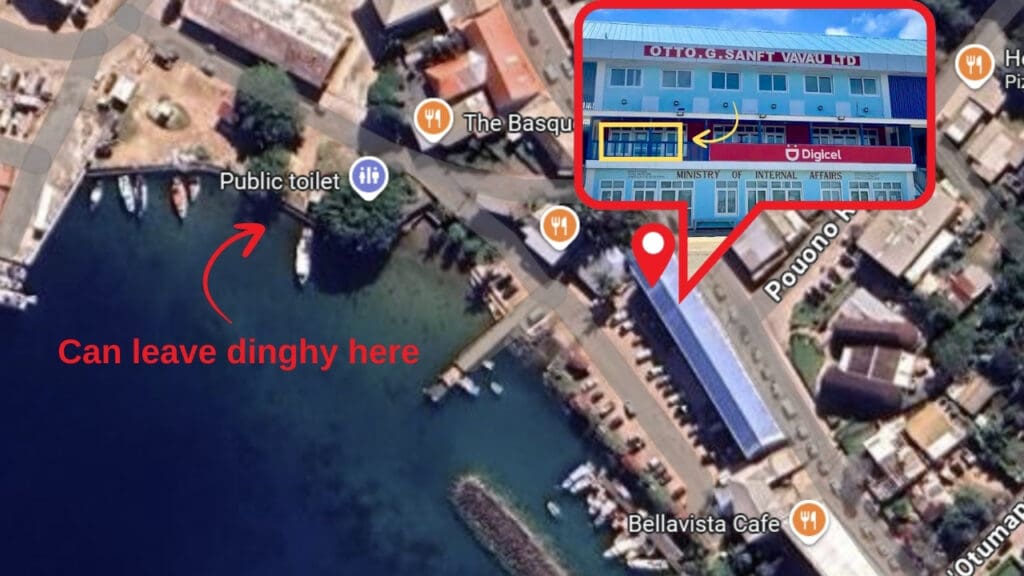
- Step 2: They will give you a form to fill out and will make copies of your passports. We extended our visitor visa for 3 months. I believe you can extend a visitor visa up to 6 months. We were not required to submit additional passport photos.
- Step 3: Pay the fee (69 TOP per person, per month). They will stamp your passport, handwrite the new visa expiration date, and give you a receipt.
Check-out procedure: We checked out of the country in Pangai (Haʻapai). The process is as follows:
- Step 1: Walk to the Ministry of Infrastructure to pay a fee. There was no sign when we went, so we have included a photo of the front of the building– if you pass the cemetery, you’ve walked too far! The fee is cash only and calculated by your boat’s tonnage. They asked to see our Certificate of Documentation. We paid 27.40 TOP.
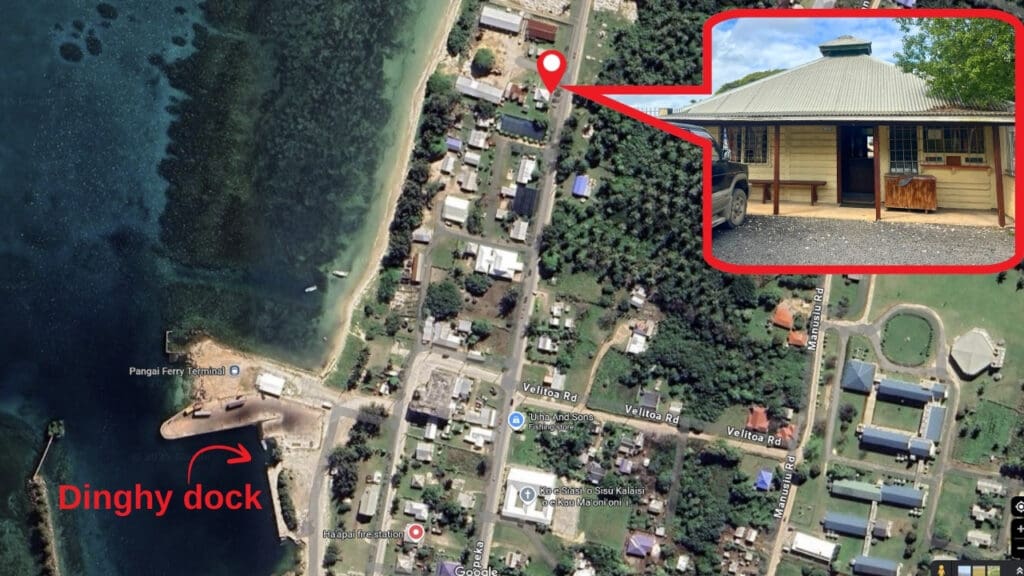
- Step 2: Bring the receipt from the Ministry of Infrastructure to the Customs Office along with your passports, boat documentation, and any other official receipts you’ve collected from your time in Tonga (i.e., lights and buoy fee from Vava’u). To find the office, turn right before the white cell phone tower on Faifekau Rd. It’s an unmarked dirt path.
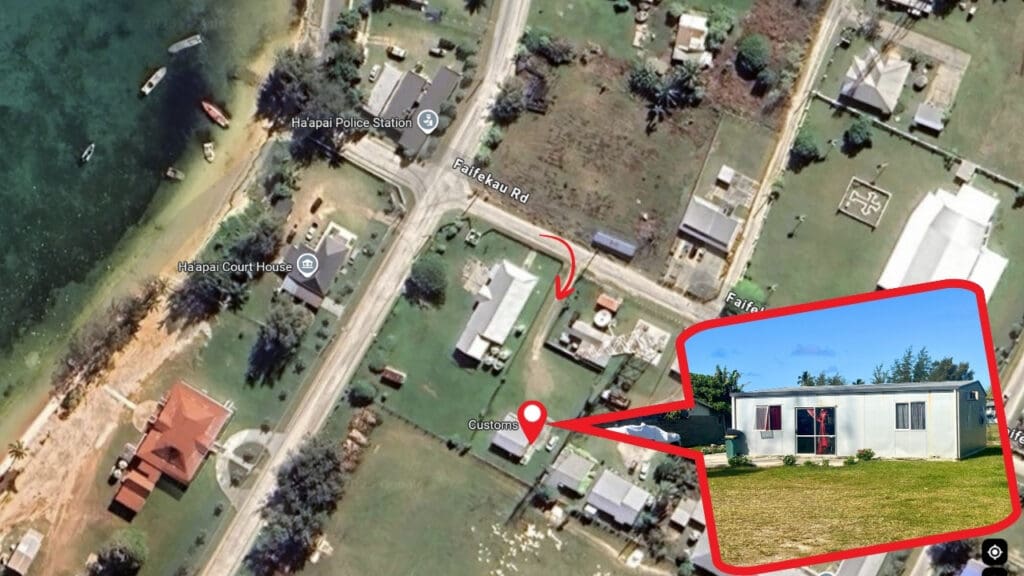
- Step 3: The official will provide you with all necessary forms to complete the check-out process. You should leave with a single page document titled “Certificate of Clearance”. We were not boarded while checking out of the country here.
NEIAFU, VAVA’U
Cruisers net 8:30AM Monday-Saturday on VHF Channel 26.
Mooring Balls: Beluga Dive Shop owns the yellow mooring balls. No reservations are required; you can pick up any open yellow ball and dinghy to their office (walk up the outdoor staircase to the second floor) to pay. They charged us 20 TOP per night. You may see their staff around the harbor on an aluminum dinghy. If there is no wind, some of the balls are placed close enough together that, depending on the size of the vessels attached, can collide. Be vigilant and have fenders ready!
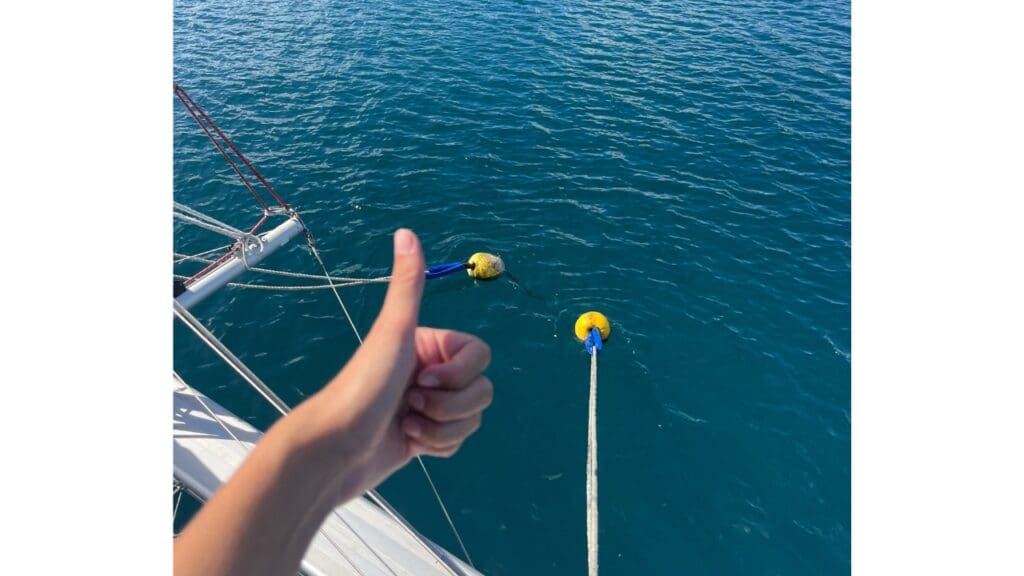
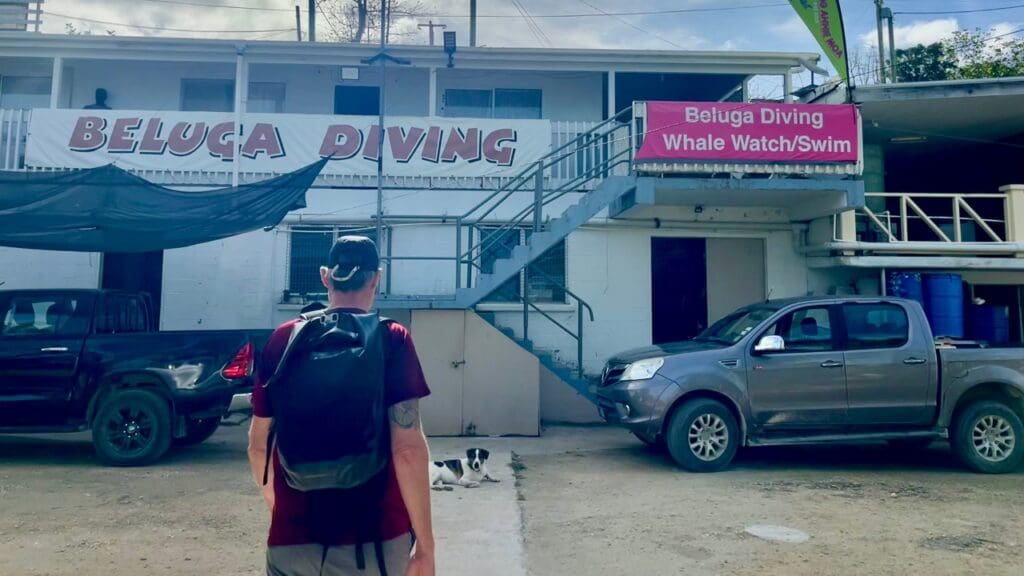
ATMs: There is an ATM outside of Cafe Tropicana and another at the Bank of South Pacific (BSP). We used both without any issues.
Trash Disposal: There is free trash disposal for yachts. Dinghy to the dock in front of Lesina’s Guest House and look for black bins with yellow lids, usually labeled “waste from yachts only”.
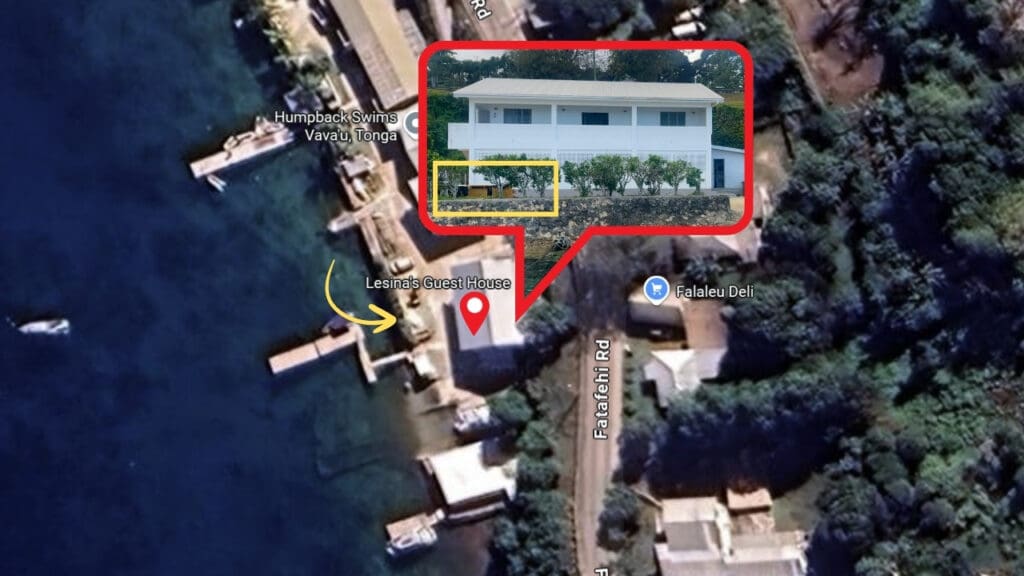
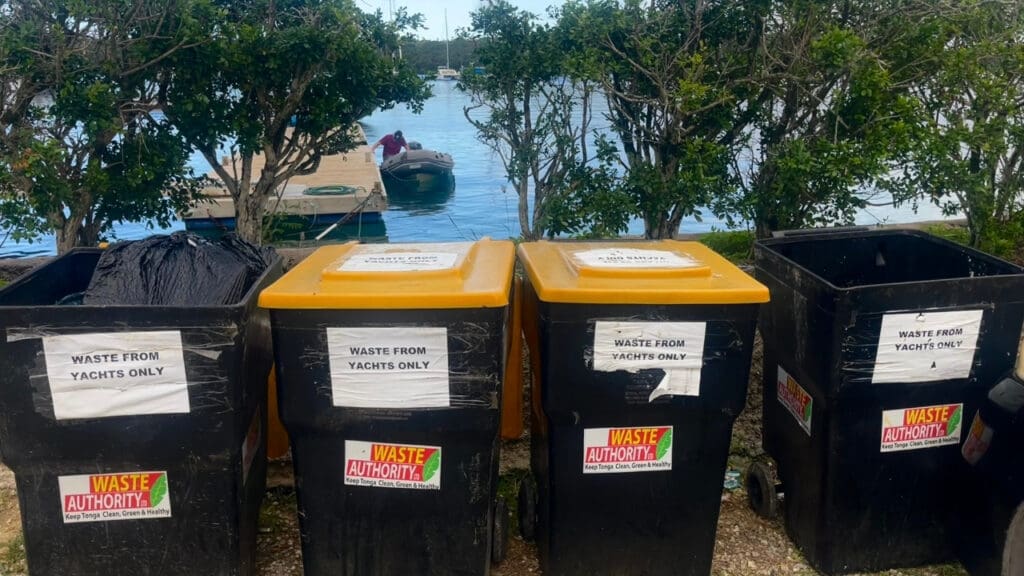
Yacht Services:
- You can arrange for your fuel jerry jugs to be picked up, filled, and returned to you at the dinghy dock via WhatsApp: +676 881 2347. We paid the fuel cost plus a small fee for the service (~10 TOP).
- Laundry can be dropped off at Mango Restaurant & Bar on Tuesday and Thursday at 10AM. Drop your bags (labeled with your boat name) by the whiteboard at the entrance. The laundry is typically done and ready for pickup the day after. You pay (cash only) when you pick up.
- Inquire at Mango about refilling your propane tanks. They filled ours quickly for a fair price.
- The owner of Mango, Adrian, is very friendly and eager to help cruisers. You may use his dinghy dock even when not dining at his restaurant. Take the staircase behind the building to get up to the main road.
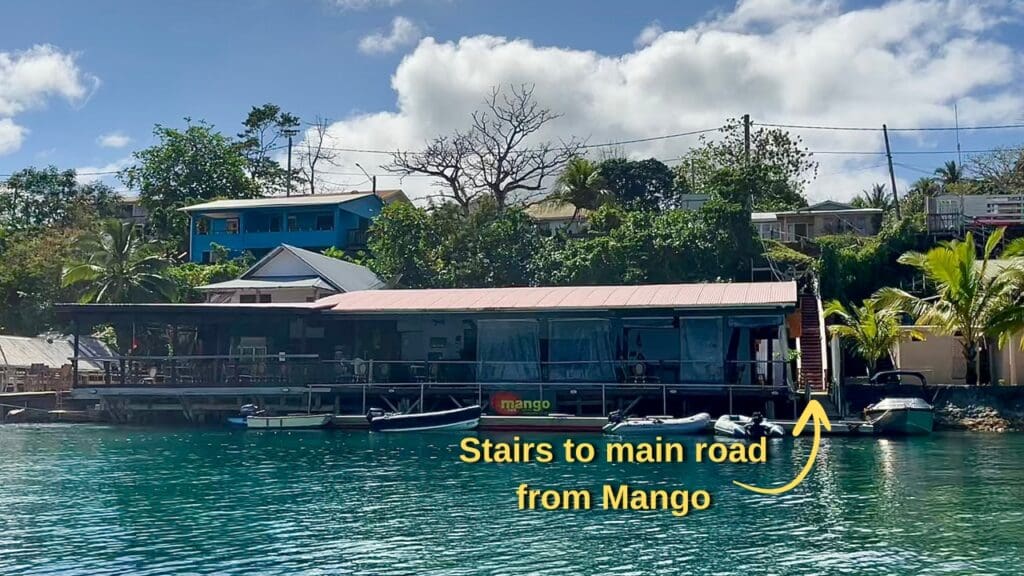
Provisioning:
- Falaleu Deli sells meat imported from New Zealand if you need to restock your freezer. We loved their roasted chicken sausage and ribeye steaks (when they’re available)! They also sell sauces, local coffee beans, cheese, and frozen pre-made meals. You can order via email or WhatsApp (contact info is in the bottom right corner of the menu photos below) or walk in and purchase whatever is available. Cash only.


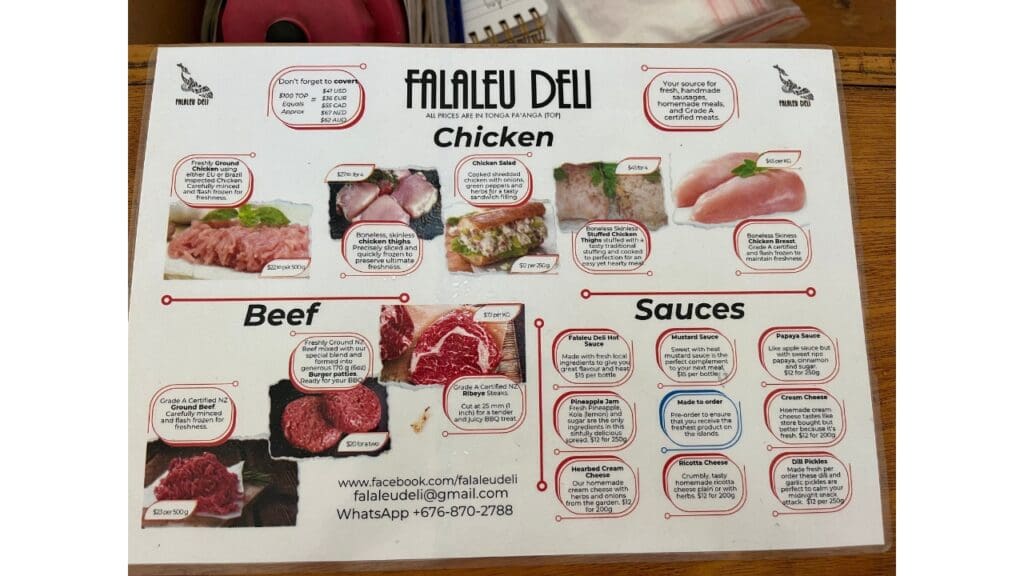
- There is a fresh outdoor market (fruit, vegetables, sometimes eggs) Monday-Saturday across the street from Tonga Customs/seen on Google Maps as “Farmers Market”. Come in the morning for the best selection. If it looks sparse, you can ask the people selling when their next shipment arrives. Cash only.
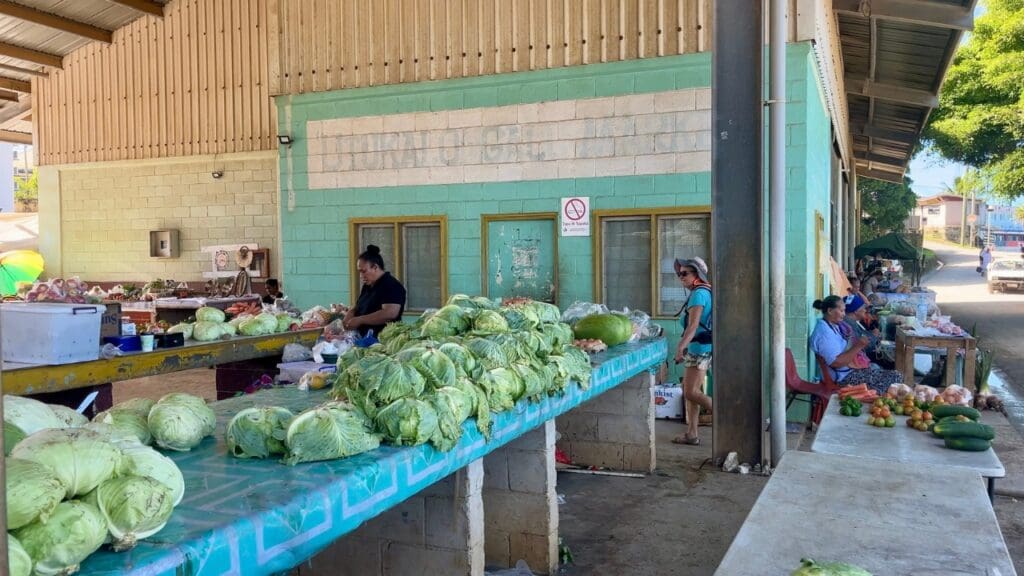
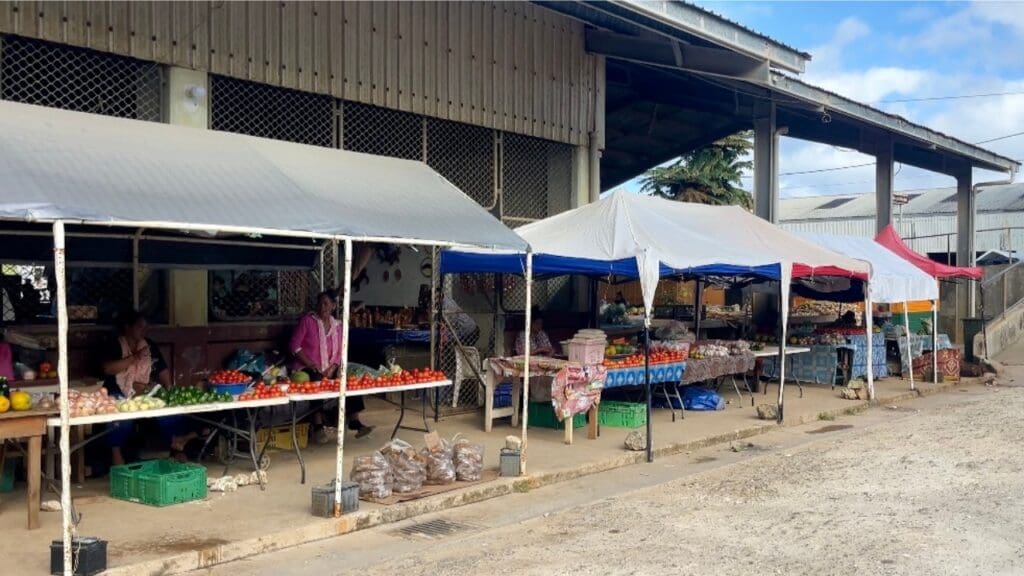
- For dry/canned goods, snacks, and condiments, check out SnAB Enterprises (located next to the ice cream shop, down the street from the FedEX). This is the only Tongan-owned grocery store in the area.

- There are many “Chinese Marts” throughout Tonga offering a variety of groceries and household supplies at low prices. While it’s great to support local Tongan-owned businesses, like the fresh market, Falaleu Deli, and SnAB, the Chinese Marts often stock items that are hard to find elsewhere. So if you’re after something specific, they’re worth checking out. For more context regarding the presence of Chinese businesses in Tonga, check out this blog post.
Parts & Repairs:
- There is a small chandlery called The Yacht Shop that sells a selection of parts, boat cleaning supplies, and fishing gear. There is also a large hardware store next door to the FedEx on Fatafehi Rd. We have no experience shipping parts in.
PANGAI, HA’APAI
See the check-out procedure section for information on Customs Office and the Ministry of Infrastructure locations in Pangai.
Note: The dinghy dock at the wharf is underwater at high tide, and very slippery at low tide— use caution.
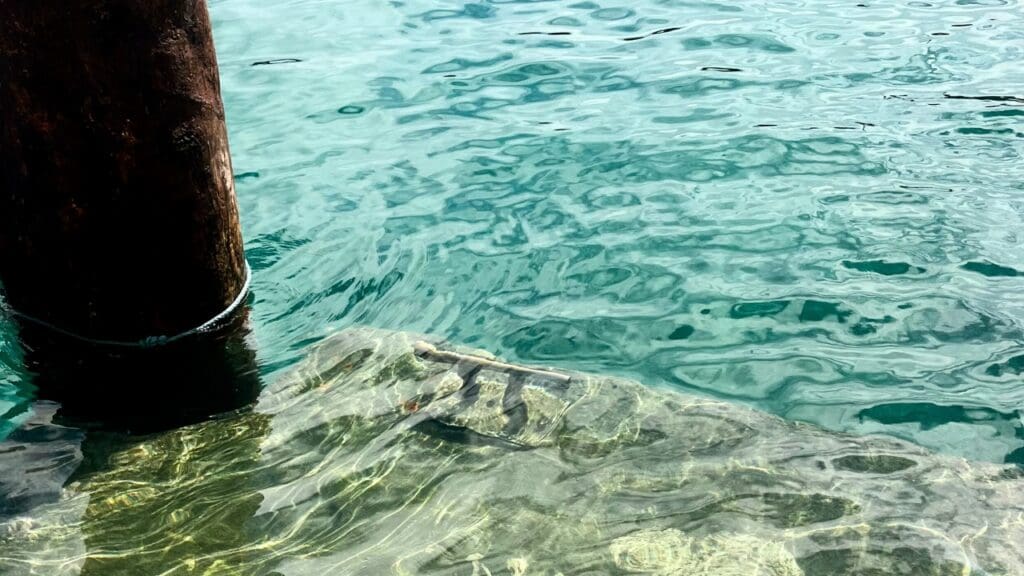
ATMs: We used the BSP ATM on Hala Holopeka road (look for the large green sign) with no issues.
Trash disposal: There are trash cans all over Pangai. We used the ones near the dinghy dock (free).
Fuel: We hitchhiked to the talikavenga gas station one afternoon. They said they were out of diesel but we could return in a few days. If we brought our empty jerry jugs, they said they would drive us back to the dinghy dock with the filled ones. Alternatively, we could have beached the dinghy closer to the fuel station, and it would’ve been walkable (there is a small path through the trees from the beach). We ended up returning to Vava’u instead and refueled there.
Provisioning: There is a small fresh market with seemingly no schedule, perhaps only open when they have a surplus to sell. You can look up RayLela’s Cake & Ice Cream Shop on Google Maps to get you into the right area, then look for the building with a fruit and vegetable mural painted on the outside. Cash only. Across the street from the market there is a Tongan owned shop that sells canned/dry goods, and some frozen meat & vegetables. There are also several Chinese Marts selling various snacks/household goods.
Parts & repairs: There is a hardware store next to the BSP ATM on Hala Holopeka road. The Tongan owned shop across the street from the fresh market is also kind of a combo hardware + grocery store. We did not see any marine specific stores.
We hope you found this free, quick logistical guide helpful! Safe sailing. 🙂

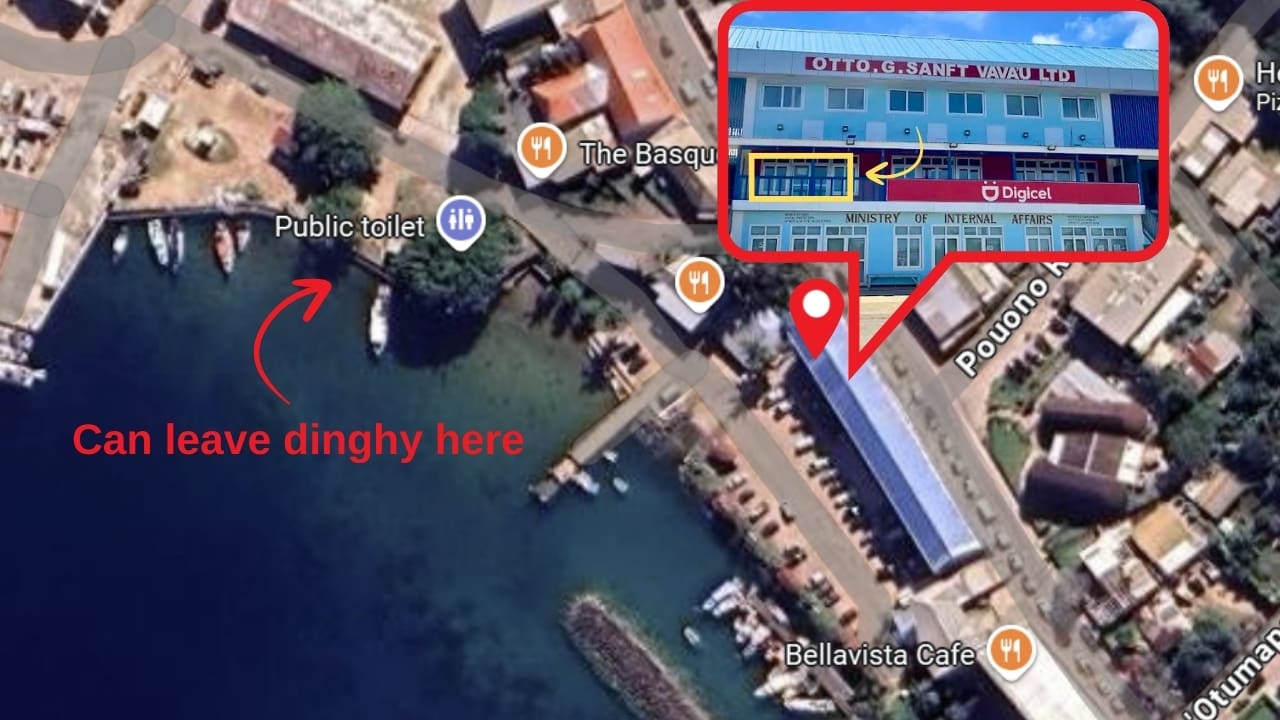
4 Responses
Hi – of course i am not going to do any of this, but i still loved the pictures. any chance of anything underwater? any eta for New Zealand?
We are in NZ! Took a while to create the map images and compile the checkout info for this guide so we couldn’t post it in real-time. 🙂
Very helpful! I had no idea we were supposed to save our mooring receipts, but will do that from now on.
You don’t need to keep mooring receipts, but any government receipts like the check in fees, lights and buoy fees, or visa fees should be kept! We didn’t keep all of ours and they still allowed us to check out of the country, but we were asked to present them when clearing out and she didn’t seem very pleased that we didn’t have them (oops!)